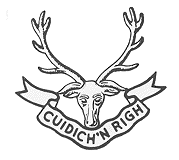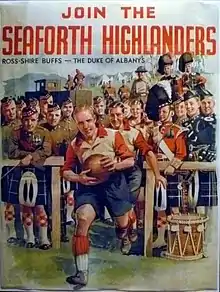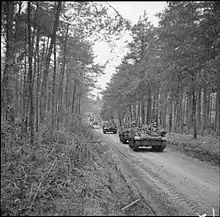Seaforth Highlanders
The Seaforth Highlanders (Ross-shire Buffs, The Duke of Albany's) was a historic line infantry regiment of the British Army, mainly associated with large areas of the northern Highlands of Scotland. The regiment existed from 1881 to 1961, and saw service in World War I and World War II, along with many smaller conflicts. In 1961 the regiment was amalgamated with the Queen's Own Cameron Highlanders to form the Queen's Own Highlanders (Seaforth and Camerons), which merged, in 1994, with the Gordon Highlanders to form the Highlanders (Seaforth, Gordons and Camerons). This, however, later joined the Royal Scots Borderers, the Black Watch, the Royal Highland Fusiliers (Princess Margaret's Own Glasgow and Ayrshire Regiment) and the Argyll and Sutherland Highlanders to create the present Royal Regiment of Scotland.
| Seaforth Highlanders | |
|---|---|
 Regimental cap badge of the Seaforth Highlanders. | |
| Active | 1881–1961 |
| Country | |
| Branch | |
| Type | Infantry |
| Role | Line infantry |
| Part of | Highland Brigade |
| Garrison/HQ | Fort George, Inverness |
| Motto(s) | Cuidich 'n Righ (Aid the King) |
| Battle honours | See below |
| Commanders | |
| Current commander | N/A |
| Ceremonial chief | N/A |
| Colonel of the Regiment | The Duke of Windsor |
| Insignia | |
| Tartan | _tartan.png.webp) |
History
Formation
The regiment was created through the amalgamation of the 72nd (Duke of Albany's Own Highlanders) Regiment of Foot and the 78th (Highlanders) (Ross-shire Buffs) Regiment of Foot, as part of the Childers Reforms of the British Army in 1881.[1] It was named after Kenneth Mackenzie, 1st Earl of Seaforth, who had originally raised the 72nd Regiment.[2] Originally named "Seaforth Highlanders (Ross-shire Buffs)", Queen Victoria approved on 22 November 1881 to style the regiment forthwith as "Seaforth Highlanders (Ross-shire Buffs, The Duke of Albany's)".[3] The 1st battalion saw action at the Battle of Tel el-Kebir in September 1882 during the Anglo-Egyptian War.[4] After returning home, the 1st battalion again went abroad in 1896, taking part in the International Occupation of Crete in 1897[5] and the reconquest of the Sudan, being present at the Battle of Atbara in April[6] and the Battle of Omdurman in September 1898.[7] They then moved to Cairo,[8] and from late 1902 was posted in India, where they were stationed at Nasirabad, Ajmer.[9]
Meanwhile, the 2nd battalion were stationed in India. They saw service on the North West Frontier, taking part in the Hazara Expeditions in the summer 1888 and the spring of 1891,[10] and the Chitral Expedition in spring 1895.[11] Returning home in 1897, the outbreak of the Second Boer War saw the 2nd Battalion travel to South Africa in November 1899, suffering heavy losses at the Battle of Magersfontein in December 1899 and at the Battle of Paardeberg in February 1900.[12]
A 3rd, Militia battalion (formerly the Highland Rifle Militia), was embodied in late 1899, and embarked in February 1900 for service in Egypt alongside the 1st battalion.[13]
In 1908, the Volunteers and Militia were reorganised nationally, with the former becoming the Territorial Force and the latter the Special Reserve;[14] the regiment now had one Reserve and three Territorial battalions.[15][1]
First World War

Regular Army
The 1st Battalion, which had been serving in India, landed at Marseilles as part of the Dehra Dun Brigade in the Meerut Division in October 1914 for service on the Western Front.[16] It saw action at the Battle of Aubers Ridge in May 1915.[17] The battalion then moved to Mesopotamia in December 1915, where it took part in the Siege of Kut later that month and the Fall of Baghdad in March 1917, before moving to Palestine in January 1918.[16]
The 2nd Battalion, which had been stationed at Shorncliffe Camp, landed at Boulogne-sur-Mer as part of the 10th Brigade in the 4th Division in August 1914.[16] It took part in the retreat from Le Cateau later that month, the Battle of the Marne in September 1914, the Battle of the Aisne also in September 1914 and the Battle of Messines in October 1914.[18] It went on to fight in the Second Battle of Ypres in April 1915, the Battle of the Somme in Autumn 1916 and the Battle of Arras in April 1917.[18] The battalion also saw action at the Battle of Passchendaele in Autumn 1917, the Battle of the Lys in April 1918, the battles of the Hindenburg Line and the final advance in Picardy.[18]
Territorial Force
_Battalion_Seaforth_Highlanders_shoulder_title.jpg.webp)
The 1/4th (Ross Highland) Battalion landed at Le Havre as part of the 152nd Brigade in the 51st (Highland) Division in November 1914 for service on the Western Front.[16] The 1/5th (The Sutherland and Caithness) Battalion and the 1/6th (Morayshire) Battalion both landed in France as part of the 152nd Brigade in the 51st (Highland) Division in May 1915 for service on the Western Front.[16]
New Armies
.jpg.webp)
The 7th (Service) Battalion landed at Boulogne-sur-mer as part of the 26th Brigade in the 9th (Scottish) Division in May 1915 for service on the Western Front.[16] The 8th (Service) Battalion landed at Boulogne-sur-mer as part of the 44th Brigade in the 15th (Scottish) Division in July 1915 for service on the Western Front.[16] The 9th (Service) Battalion landed at Boulogne-sur-mer as part of the pioneer battalion for the 9th (Scottish) Division in May 1915 for service on the Western Front.[16]
The 1st Garrison Battalion landed in Salonika as part of the 228th Brigade in the 28th Division in August 1916 for service on the Salonika Front.[16]
Interwar years
In 1921, the 1st Battalion was deployed to Cowdenbeath and to Bridge of Allan to maintain order during strike action by the miners.[19] It moved to Palestine in 1933 and to Hong Kong in 1937.[20] Meanwhile, the 2nd Battalion went to India in 1918 and saw action on the North-West Frontier in 1930 before moving moved to Palestine in 1932.[20]
Second World War

The 1st Battalion, which was in China when war broke out, was deployed to Malaya in November 1940, for service in the Burma Campaign.[20] It joined the 1st Indian Brigade in the 23rd Indian Division in May 1942.[20]

The 2nd Battalion went to France as part of the 152nd Brigade in the 51st Highland Division with the British Expeditionary Force (BEF) in October 1939 but was captured at Saint-Valery-en-Caux during the Battle of France in June 1940.[20] The 2nd Battalion was reconstituted, as part of a reconstituted 152nd Brigade in a reconstituted 51st (Highland) Division, and served in the Middle East, fighting in the Second Battle of El Alamein, and the subsequent Tunisia Campaign, in the Allied invasion of Sicily.[20] In late 1943 the 51st Division returned to the United Kingdom and then took part in Operation Overlord, the Allied invasion of Normandy, taking part in Operation Totalize and Operation Astonia, the capture of the French port of Le Havre.[20] The battalion later participated in Operation Veritable, Operation Plunder and the Western Allied invasion of Germany.[21]
The 4th Battalion also went to France as part of the 152nd Brigade in the 51st Highland Division with the BEF in January 1940 and was also captured at Saint-Valery-en-Caux in June 1940.[22]
The 5th Battalion formed part of the reconstituted 152nd Brigade in the reconstituted 51st Highland Division,[23] and served in the Middle East, in the Allied invasion of Sicily in July 1943, in the Allied invasion of Italy in September 1943 and then in North-West Europe.[24]

The 6th Battalion was a 2nd Line TA unit that was transferred to the 17th Infantry Brigade, part of the 5th Infantry Division. It served with the division throughout the war in Sicily, Italy, and finally in Northwest Europe.[25]
The 7th Battalion was a 2nd Line TA unit that was originally serving with the 26th Infantry Brigade, part of the 9th (Highland) Infantry Division, and later transferred to the 46th (Highland) Infantry Brigade in the 15th (Scottish) Infantry Division and deployed to France in June 1944: it saw action in Operation Epsom and then served in North-West Europe.[26]
Postwar and amalgamation
The regiment amalgamated with the Queen's Own Cameron Highlanders on 7 February 1961 at Redford Barracks to form the Queen's Own Highlanders (Seaforth and Camerons).[27]
Battle honours
This list contains all battle honours awarded to the Seaforth Highlanders (Duke of Albany's, Ross-shire Buffs) 72nd Highlanders and 78th Highlanders together with:[1]
- Early Wars: Carnatic, Mysore, South Africa 1835, Egypt 1882, Tel-El-Kebir, Chitral, Khartoum, Atbara, Paardeberg, South Africa 1899-1902
- The Great War: Le Cateau, Retreat from Mons, Marne 1914 '18 Aisne 1914, La Bassée 1914, Armentières 1914, Festubert 1914 '15, Givenchy 1914, Neuve Chapelle, Ypres 1915 '17 '18, St. Julien, Frezenberg, Bellewaarde, Aubers, Loos, Somme 1916 '18, Albert 1916, Bazentin, Delville Wood, Pozières, Flers-Courcelette, Le Transloy, Ancre Heights, Ancre 1916, Arras 1917 '18, Vimy 1917, Scarpe 1917 '18, Arleux, Pilckem, Menin Road, Polygon Wood, Broodseinde, Poelcapelle, Passchendaele, Cambrai 1917 '18, St. Quentin, Bapaume 1918, Lys, Estaires, Messines 1918, Hazebrouck, Bailleul, Kemmel, Béthune, Soissonnais-Ourcq, Tardenois, Drocourt-Quéant, Hindenburg Line, Courtrai, Selle, Valenciennes, France and Flanders 1914–18, Macedonia 1917–18, Megiddo, Sharon, Palestine 1918, Tigris 1916, Kut al Amara 1917, Baghdad, Mesopotamia 1915-18
- The Second World War: Ypres-Comines Canal, Somme 1940, Withdrawal to Seine, St. Valery-en-Caux, Odon, Cheux, Caen, Troarn, Mont Pincon, Quarry Hill, Falaise, Falaise Road, Dives Crossing, La Vie Crossing, Lisieux, Nederrijn, Best, Le Havre, Lower Maas, Meijel, Venlo Pocket, Ourthe, Rhineland, Reichswald, Goch, Moyland, Rhine, Uelzen, Artlenberg, North-West Europe 1940 '44-45, El Alamein, Advance to Tripoli, Mareth, Wadi Zigzaou, Akarit, Djebel Roumana, North Africa 1942–43, Landing in Sicily, Augusta, Francoforte, Adrano, Sferro Hills, Sicily 1943, Garigliano Crossing, Anzio, Italy 1943–44, Madagascar, Middle East 1942, Imphal, Shenam Pass, Litan, Tengnoupal, Burma 1942-44
(Those borne on the Colours are in bold type)
Victoria Cross recipients
The following servicemen from the Seaforth Highlanders were awarded the Victoria Cross:
- Andrew Bogle, 78th Highlanders, 1857, Indian Mutiny
- Joseph Crowe, 78th Highlanders, 1857, Indian Mutiny
- Herbert MacPherson, 78th Highlanders, 1857, Indian Mutiny
- Joseph Jee, 78th Highlanders, 1857, Indian Mutiny
- Valentine McMaster, 78th Highlanders, 1857, Indian Mutiny
- Stewart McPherson, 78th Highlanders, 1857, Indian Mutiny
- Henry Ward, 78th Highlanders, 1857, Indian Mutiny
- James Hollowell, 78th Highlanders, 1857, Indian Mutiny
- Aylmer Cameron, 72nd Duke of Albany's Own Highlanders, 1858, Indian Mutiny
- George Sellar, 72nd Duke of Albany's Own Highlanders, 1879, Afghanistan
- John MacKenzie, Seaforth Highlanders, 1900, Ashanti
- Sidney Ware, 1st Bn Seaforth Highlanders, 1916, First World War
- Walter Ritchie, 2nd Bn Seaforth Highlanders, 1916, First World War
- Thomas Steele, 1st Bn Seaforth Highlanders, 1917, First World War
- Donald MacKintosh, 2nd Bn Seaforth Highlanders, 1917, First World War
- Alexander Edwards, 6th Bn Seaforth Highlanders, 1917, First World War
- Robert McBeath, 5th Bn Seaforth Highlanders, 1917, First World War
- John Meikle, MM.4th Bn Seaforth Highlanders, 1918, First World War
Colonels-in-Chief
- 1881–1884: Col. HRH Prince Leopold, Duke of Albany, KG, KT, GCSI, GCMG, KJStJ
- 1905: HRH Prince Charles Edward, Duke of Albany, KG, GCVO (terminated 1917)
- 1920: F.M. HM King Edward VIII
Regimental Colonels
Colonels of the Refiment were:[1]
- 1881–1893 (1st Battalion): Gen. Sir Edward Selby Smyth, KCMG (ex 72nd Foot)
- 1881–1885 (2nd Battalion): F.M. Sir Patrick Grant, GCB, GCMG (ex 78th Foot)
- 1893–1897: Gen. Sir William Parke, KCB
- 1897–1907: Gen. Sir Archibald Alison, Bt., GCB
- 1907–1911: Lt-Gen. Mostyn de la Poer Beresford
- 1911–1914: Gen. Sir George Digby Barker, GCB
- 1914–1924: Maj-Gen. Robert Hunter Murray, CB, CMG
- 1924–1931: Maj-Gen. Sir Colin John Mackenzie, KCB
- 1931–1939: Maj-Gen. Sir Archibald Buchanan Ritchie, KBE, CB, CMG
- 1939–1947: Lt-Gen. Sir William Montgomery Thomson, KCMG, CB, MC
- 1947–1957: Maj-Gen. Sir John Emilius Laurie, Bt., CBE, DSO
- 1957–1961: F.M. Sir Archibald James Halkett Cassels, GCB, KBE, DSO (to Queen's Own Highlanders)
- 1961 Regiment amalgamated with The Queen's Own Cameron Highlanders to form the Queen's Own Highlanders (Seaforth and Camerons)
See also
References
- "Seaforth Highlanders (Ross-shire Buffs, The Duke of Albany's)". Regiments.org. Archived from the original on December 29, 2005. Retrieved 15 May 2016.
- Paul, James Balfour (1910). The Scots Peerage. 7. David Douglas, Edinburgh. pp. 512–513.
- "War Office Memorandum". The London Gazette (25040). Government of the United Kingdom. 22 November 1881. p. 5713. Retrieved 27 October 2016.
- "Battle of Tel-El-Kebir 1882". British Battles. Retrieved 15 May 2016.
- Sym, p. 104
- "Battle of Atbara 1898". British Battles. Retrieved 15 May 2016.
- "Battle of Omdurman 1898". British Battles. Retrieved 15 May 2016.
- Sym, p. 329
- "Naval & Military intelligence - The Army in India". The Times (36896). London. 11 October 1902. p. 12.
- Sym, p. 114-5
- "The Siege and Relief of Chitral". British Battles. Retrieved 15 May 2016.
- "Seaforth Highlanders (Duke of Albany's Ross-shire Buffs)". Anglo-Boer War. Retrieved 8 May 2016.
- "The War - embarkation of troops". The Times (36066). London. 15 February 1900. p. 4.
- "Territorial and Reserve Forces Act 1907". Hansard. 31 March 1908. Retrieved 20 June 2017.
- These were the 3rd Battalion (Special Reserve), with the 4th (Ross-shire) Battalion at Ferry Road in Dingwall, the 5th (The Sutherland and Caithness Highland) Battalion at Old Bank Road in Golspie and the 6th (Morayshire) Battalion at Cooper Park in Elgin (all Territorial Force)
- "Seaforth Highlanders". The Long, Long Trail. Retrieved 15 May 2016.
- "Seaforth Highlanders 1st Btn during the Great War". The Wartime Memories Project. Retrieved 15 May 2016.
- "Seaforth Highlanders 2nd Btn during the Great War". The Wartime Memories Project. Retrieved 15 May 2016.
- Sym, p. 330
- "Seaforth Highlanders (Ross-shire Buffs, The Duke of Albany's)". National Army Museum. Retrieved 16 May 2016.
- "Goch: the final objective". 51st Highland Division. Retrieved 26 September 2016.
- "Seaforth Highlanders 4th Bn". Wartime Memories. Retrieved 21 May 2016.
- Beevor, Antony (2005). Ardennes 1944: Hitler's Last Gamble. Penguin. ISBN 978-0670918645.
- "Alastair Borthwick". The Telegraph. 4 October 2003. Retrieved 21 May 2016.
- "17th Brigade Order of Battle". OrdersOfBattle.com. Retrieved 11 April 2017.
- "7th Battalion, Seaforth Highlanders". WarCemeteries.nl. Retrieved 20 May 2016.
- "Queen's Own Highlanders (Seaforth and Camerons)". Regiments.org. Archived from the original on December 30, 2005. Retrieved 15 May 2016.
Sources
| Wikimedia Commons has media related to Seaforth Highlanders. |
- Sym, John M. (1962). Seaforth Highlanders. Gale & Polden.
